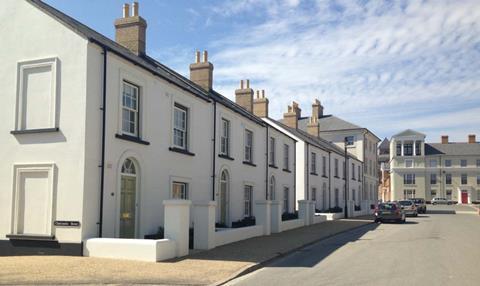Nicholas Boys Smith will also head up ’expert group’ to advise ministers on housing design
The government has appointed Create Streets founder Nicholas Boys Smith to establish its new quango responsible for driving up housing design standards.
Boys Smith, who was also the co-chair with the late Roger Scruton of the government’s Building Better, Building Beautiful Commission and is associated with promoting traditional over contemporary design, will oversee the setting up of the new design body.
Housing secretary Robert Jenrick said Boys Smith had established himself as “the pre-eminent voice in the movement to create beautiful, sustainable neighbourhoods”.

Architects frequently voice unease over Create Streets’ design agenda and were in uproar over the appointment of Scruton, a philosopher with conservative views on architecture and other subjects, to the beauty commission. But they were broadly supportive of the commission’s final report which is understood to have been largely written by Boys Smith.
The as-yet unnamed new quango was announced in last month’s planning white paper, Planning for the Future, which said a new body was needed to support the delivery by local authorities of design codes in every part of the country, as well as embed the work of the Beauty Commission in the reformed planning system.
Urbed is working on the national model design code which can be adapted for use by individual local authorities. It is expected to go out for consultation towards the end of the year.

Design codes, such as those used at Poundbury in Dorset, are set to play a much bigger part in the planning system under the government’s planning reforms which envisage them guiding the delivery of developments granted approval in principle in local plans.
Jenrick said Boys Smith has also been asked to lead an “expert group advising government on how to embed beauty and quality into the new, reformed planning system”.
The housing ministry said the appointment of Boys Smith “marks the next step in placing beauty and design firmly at the heart of the government’s new planning system”.
Jenrick has also appointed Charles O’Brien, a Historic England commissioner and editor of the Pevsner architectural guides, as the government’s new heritage advisor to help protect “treasured historic buildings and monuments”.
Jenrick, who is due to give a keynote speech to the Create Streets annual conference today, is expected to claim the government was now “for the first time […] embedding beauty, design and quality in the planning system”, and that Nicholas Boys Smith had been given the job as he had established himself as “the pre-eminent voice in the movement to create beautiful, sustainable neighbourhoods with an enduring appeal.”
According to the housing ministry, Jenrick will go on to say: “The creation of a new design body will empower communities to demand developments are built to local preferences and reflect the character and identity of their communities - assigning ‘anywhereville’ developments to history.”
>> Also read: Architects respond to beauty commission report
>> Also read: Government urged to set up design quality unit for England
Despite these claims, the government has been sharply criticised for its planning reforms, which include the expansion of permitted development, despite evidence it produces poorly designed buildings that are more likely to harm their inhabitants. The white paper has also been criticised for reducing democratic accountability in the system by giving automatic permission.
The decision to set up a new design body follows the abolition in 2011 of former design body Cabe, set up by the Labour government, under David Cameron’s “bonfire of the quangos”.
The white paper said the new body will be designed to “help authorities make effective use of design guidance and codes, as well as performing a wider monitoring and challenge role for the sector in building better places.” It said that this could be achieved either by setting up a new arms-length body reporting to government, or through a new centre of expertise within Homes England, or by reinforcing the existing network of architecture and design centres.
Boys Smith said: “New places should be the conservation areas of the future: popular, beautiful, sustainable and supportive of public health and well-being. I am delighted to be asked to be help achieve that and look forward to getting stuck in.”
Kathryn Hampton, senior expertise lawyer at law firm Ashurst, said the industry had concerns about the expansion in the use of design codes. She said: “A clearer steer on design can be very helpful, but there is a degree of unease about clarity, viability and the potential threat to individualism, particularly in light of the “pattern book” references in the recent white paper.
“Professional support for local communities should help to allay some of these concerns, provided that variety in design is one of the objectives. It’s important that the support is on-going and that more detail is provided on how the codes will work as part of the new local plan process.”
















2 Readers' comments